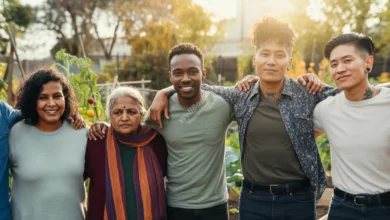Mobilizing Community Mental Health Support in Crisis Times

Introduction: The Power of Community in Mental Health
Did you know that community support can reduce the risk of mental health problems by up to 30%? In times of crisis, this support becomes even more crucial. Whether we’re facing a global pandemic, natural disaster, or economic downturn, our mental health is often the first casualty. But there’s hope – and it lies within our own neighborhoods.
Community mental health support isn’t just a nice idea; it’s a powerful tool that can change lives. When we come together to support each other’s mental well-being, we create a safety net that catches those who might otherwise fall through the cracks.
Understanding Mental Health Crises: More Than Just a Bad Day
Let’s start by clearing up what we mean by a mental health crisis. It’s not just feeling down or stressed – it’s a situation where someone’s mental or emotional state puts them or others at risk. These crises can be triggered by various events:
- Natural disasters like hurricanes or earthquakes
- Global health emergencies like pandemics
- Economic downturns leading to job losses
- Personal traumas such as loss of a loved one
During these times, our minds can feel like they’re under siege. Anxiety skyrockets, depression deepens, and for some, the world can seem unbearably dark. But here’s the good news: we don’t have to face these challenges alone.
The Role of Community Support: A Lifeline in Troubled Times
Imagine a world where every neighborhood had a mental health support system as reliable as its fire department. That’s the power of community mental health support. Research shows that strong community ties can:
- Reduce feelings of isolation and loneliness
- Provide practical help during difficult times
- Offer emotional support and understanding
- Create a sense of belonging and purpose
A study published in the Journal of Community Psychology found that communities with strong social support networks had significantly lower rates of mental health issues during and after crises. This isn’t just feel-good science – it’s a roadmap to resilience.
Identifying Mental Health Needs: Spotting the Signs
Before we can help, we need to know what to look for. Here are some common signs that a community might be struggling with mental health issues:
- Increased reports of domestic violence
- Higher rates of substance abuse
- More calls to crisis hotlines
- Decreased participation in community activities
To get a clearer picture, communities can use tools like:
- Surveys: Online or door-to-door questionnaires about mental health
- Focus groups: Small group discussions to explore mental health concerns
- Data analysis: Looking at local health and crime statistics
Remember, the goal isn’t to diagnose individuals, but to understand the overall mental health landscape of your community.
Common mental health issues that often arise during crises include:
- Anxiety disorders
- Depression
- Post-traumatic stress disorder (PTSD)
- Substance abuse
- Eating disorders
By recognizing these issues early, we can start mobilizing mental health resources more effectively.
Strategies for Mobilizing Community Support: Building a Mental Health Safety Net
Now that we understand the importance of community support, let’s explore practical strategies to mobilize our neighborhoods for better mental health. These approaches can help create a robust support system during crisis times.
1. Raising Awareness: Shining a Light on Mental Health
Awareness is the first step towards action. To mobilize community support, we need to ensure everyone understands the importance of mental health. Here’s how:
- Host informational events: Organize workshops or webinars on mental health topics.
- Use social media: Share reliable mental health information on local community pages.
- Partner with local media: Work with local newspapers or radio stations to spread the word.
Key messages to include in your awareness efforts:
- Mental health is as important as physical health
- It’s okay to ask for help
- Mental health issues are common and treatable
- Supporting others’ mental health benefits the whole community
2. Building a Support Network: Strength in Numbers
Creating a strong support network involves bringing together various community stakeholders. Here’s a breakdown of potential roles:
| Stakeholder | Role in Mental Health Support |
|---|---|
| Local government | Allocate resources, create policies |
| Healthcare providers | Offer professional support, training |
| Schools | Implement mental health programs for youth |
| Religious organizations | Provide spiritual support, community outreach |
| Local businesses | Sponsor initiatives, promote work-life balance |
To build this network:
- Identify key stakeholders in your community
- Reach out and explain the importance of mental health support
- Organize a meeting to discuss collaborative efforts
- Assign roles and responsibilities
- Set up regular check-ins to monitor progress
3. Utilizing Technology and Social Media: Digital Support in a Digital Age
In today’s connected world, technology can be a powerful tool for mobilizing mental health resources. Here’s how to leverage it:
- Create online support groups: Use platforms like Facebook or Discord to host virtual support meetings.
- Promote mental health apps: Recommend reliable apps for meditation, mood tracking, or therapy.
- Develop a community mental health website: Create a central hub for local mental health resources and information.
Recommended mental health apps and online resources:
- Headspace (for meditation)
- 7 Cups (for online therapy and support)
- Moodfit (for mood tracking)
- National Alliance on Mental Illness (NAMI) website
4. Training Community Members: Empowering Everyday Heroes
Equipping community members with mental health skills can create a network of support. Consider these training options:
- Mental Health First Aid: This course teaches people how to identify, understand and respond to signs of mental illnesses and substance use disorders.
- Psychological First Aid: This training helps people support those who’ve experienced a disaster or traumatic event.
Key skills to develop in community mental health supporters:
- Active listening
- Recognizing signs of mental distress
- De-escalation techniques
- Knowledge of local mental health resources
- Self-care practices
5. Creating Safe Spaces for Discussion: Breaking the Silence
Open conversations are crucial for destigmatizing mental health. Here’s how to foster them:
- Organize regular “Mental Health Meetups” in local community centers
- Create a “Buddy System” where community members check in on each other
- Host “Story Sharing” events where people can share their mental health journeys
Tips for facilitating supportive discussions:
- Establish ground rules for respectful communication
- Encourage active listening without judgment
- Provide resources for further support after the discussion
- Ensure confidentiality to create a safe environment
By implementing these strategies, communities can create a strong foundation for mental health support during crisis times. Remember, the goal is to create a network where everyone feels supported and no one falls through the cracks.
Overcoming Challenges in Mobilizing Community Support: Navigating the Obstacles
While community mental health support is crucial, it’s not without its challenges. Let’s explore some common obstacles and how to overcome them:
- Stigma: Mental health stigma can prevent people from seeking or offering help.
- Solution: Consistently share accurate information and personal stories to normalize mental health discussions.
- Limited resources: Many communities face budget constraints.
- Solution: Seek grants, partner with local businesses, or organize fundraising events.
- Volunteer burnout: Supporting others can be emotionally taxing.
- Solution: Implement regular check-ins and self-care training for volunteers.
- Lack of expertise: Not everyone has professional mental health training.
- Solution: Partner with local mental health professionals for guidance and training.
Case Study: In 2020, the small town of Millbrook, NY, faced a mental health crisis due to the pandemic. They successfully implemented a community support program by:
- Training local barbers and hairdressers in mental health first aid
- Creating a volunteer-run crisis hotline
- Organizing weekly virtual support groups
The result? A 40% decrease in emergency mental health calls and increased community cohesion.
Sustaining Long-term Community Engagement: Keeping the Momentum
Crisis mental health initiatives shouldn’t end when the immediate danger passes. Here’s how to maintain momentum:
- Celebrate successes: Regularly acknowledge the community’s efforts and progress.
- Rotate responsibilities: Prevent burnout by sharing leadership roles.
- Continual education: Offer ongoing training and workshops to keep skills sharp.
- Adapt to changing needs: Regularly assess community mental health needs and adjust programs accordingly.
Remember, sustainable support is about creating a culture of care, not just responding to crises.
Conclusion: Building a Mentally Healthy Community Together
We’ve explored the power of community mental health support during crisis times. From raising awareness to creating safe spaces for discussion, every action counts. By mobilizing mental health resources, we can create a safety net that catches everyone.
Remember:
- Mental health is everyone’s business
- Small actions can have big impacts
- Together, we’re stronger than any crisis
Call to Action: Be the Change in Your Community
- Start a conversation about mental health with a neighbor or friend.
- Research local mental health resources and share them on social media.
- Volunteer for a local mental health organization.
- Advocate for mental health support in your local government meetings.
Your community’s mental health journey starts with you. Take that first step today.
Additional Resources
For those looking to dive deeper into community mental health support:
- National Alliance on Mental Illness (NAMI): www.nami.org
- Mental Health America: www.mhanational.org
- World Health Organization (WHO) Mental Health: www.who.int/health-topics/mental-health
Books:
- “The Community Mental Health System: A Navigational Guide for Providers” by Elizabeth L. Teed and John A. Scileppi
- “Community Mental Health: Challenges for the 21st Century” by Jessica Rosenberg and Samuel J. Rosenberg
Remember, every step towards better mental health is a step towards a stronger, more resilient community. Let’s take those steps together.



